Reaching Students with Special Needs Using Kinesthetic STEM Programs
Special Education District Uses FIRST® LEGO® League Jr. to Help Hands-on Learners Build STEM and Social Skills
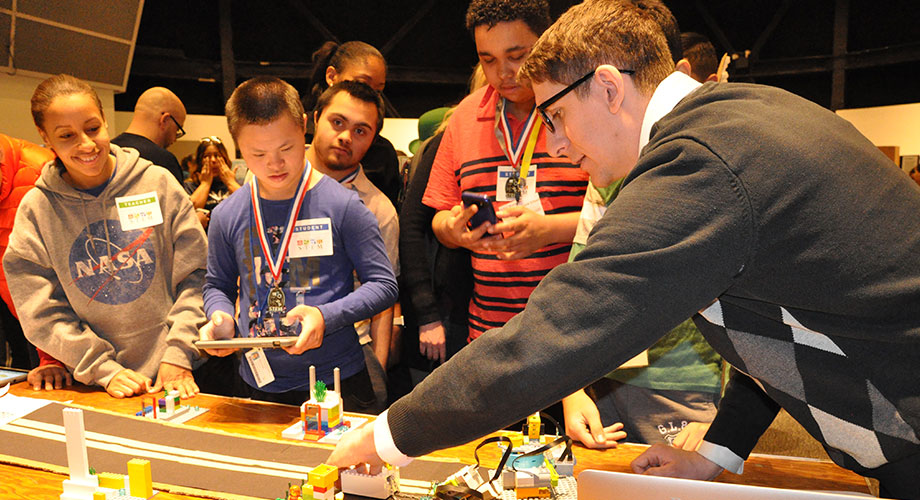
Team “Water Warriors” operate the team’s app-controlled LEGO model at District 75’s FIRST LEGO League Jr. Expo at the New York Hall of Science.
Teacher Charles Gerber was a little nervous for his students as he awaited their arrival at the New York Hall of Science. The group, nicknamed the “Water Warriors,” would be showcasing their team project and robotic model in District 75’s FIRST LEGO League Jr. Expo, attended by parents, administrators, teachers, students, and members of the community. The team, all students with special needs, had designated a spokesperson, but the student hadn’t been in school the day before.
When the Water Warriors arrived, Gerber asked three students to speak about the project in the spokesperson’s absence. “They really stepped up to the plate. I thought they excelled in explaining the project, even better than I expected,” he said. “Even the students who are nonverbal were able to use pointing [so you could] follow their thought process.”
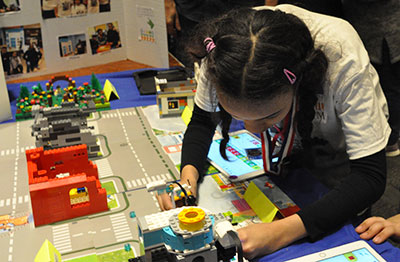
Team “Hydrobots” demonstrate a model of water-carrying robot for water treatment plants.
His team wasn’t the only one that impressed. A couple of rows away, student Janel explained how her team, the “Hydrobots,” designed a water treatment plant with a water robot that carries the clean water to a house, while her teammates demonstrated the model. “We worked as a team,” Janel said. “We worked hard.”
A few more tables over, a student from the “Engineering Eagles” used assistive technology to demonstrate the motion-sensor bathroom shower model his team built for saving water at home.
They were among the dozens of teams from all over New York City who exhibited at the expo hosted by New York City Department of Education District 75, which provides city-wide educational, vocational, and behavior support programs for 25,000 students from pre-K to age 21 with moderate to severe disabilities. That includes students who are on the autism spectrum, are speech and language impaired, or have other significant cognitive delays or emotional challenges.
“The buy-in was immediate”
Gerber is a vocational education teacher and technology liaison for special needs students at a Queens high school. When he began working on FIRST LEGO League Jr. with his students, he said, “the buy-in was immediate.” Their enthusiasm kept them engaged and kept their frustration levels down in the problem-solving process of coding. “Even with general education students, it’s so easy for them to get frustrated and shut down. It doesn’t happen with this [program], and that’s really awesome,” he said.
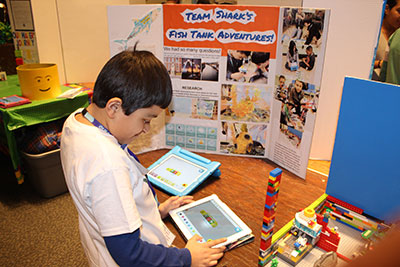
A student from “Team Shark” uses an app to program the team’s model.
FIRST LEGO League Jr. is a STEM-oriented, project-based learning experience that involves simple robotics, LEGO bricks, and a real-word theme, which changes each year. This past season, the topic was the human water cycle. Students research a topic of their choosing related to the theme. They document their findings on a Show Me Poster.
Teams also build a simple moving model using LEGO® Education WeDo 2.0 that demonstrates a concept related to the theme, and program it with block-based coding. Students celebrate their season and work at an expo, where they share their research and model with the community.
District 75 students on “Team Shark” came up with an adventure story to go with their project and model, which had three motorized elements. Their coach, tech teacher Erna Barenio, was thrilled with the students’ improvements in language, imagination, and teamwork as they built on each other’s ideas. “Language is so important for this class because a lot of them repeat words and repeat what other people say,” she said, adding, “They learned to cheer each other on and give each other turns to make their own additions. I just loved the creativity that came out of it.”
Bringing kinesthetic programs to District 75
As the director of STEM for District 75, Leslie Schecht is always looking for ways to reach kids with varying special needs – and hands-on, kinesthetic programs and curricula are key. “I’m a big believer in giving our kids as much opportunity as any other kid,” she said.
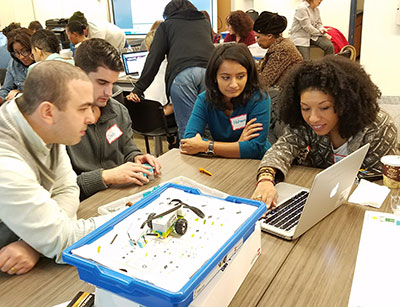
District 75 teachers attend a professional development workshop to learn about FIRST LEGO League Jr.
Schecht worked with FIRST NYC to implement professional development workshops and launch FIRST LEGO League Jr. in 22 district schools in 2016, growing to 39 schools in 2017. Next school year, she hopes to grow the program to 50 schools – which means they may quickly outgrow their exhibition space.
The expo has been a key part of the program’s success with District 75. “It’s inspirational: Kids see each other’s work and appreciate each other’s work, and they get ideas, so it’s all about moving forward,” Schecht said.
“The highest form of learning”
Shelly Klainberg, deputy superintendent of District 75, was among the expo attendees who visited each team to learn about their work. She appreciated the learning opportunity students get from both presenting to others and seeing what their peers have done. “Everybody is following the same Common Core Learning Standards, everybody is following the same theme, so [the students] learn different ways to go about things,” Klainberg said. “It’s so clear the level of engagement and rigor that took place throughout this process. Being able to explain and teach others is the highest form of learning.”
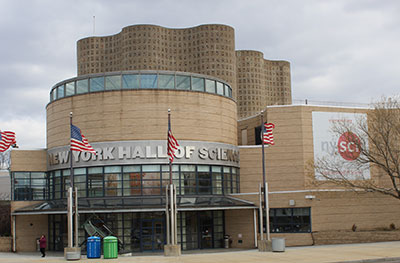
District 75 held its FIRST LEGO League Jr. Expo at the New York Hall of Science in Queens, N.Y.
Klainberg added that the student-led nature of FIRST LEGO League Jr. was important not just for the students but their teachers: “Teachers truly serve as facilitators and not managers of this process. Seeing the students take charge is so much of what we’re aiming toward, and it’s exciting to see that happen. As we go around [the expo], we hear little from the teachers – it’s all about the kids.”
Offering students a meaningful chance to shine
Jess Santiago-Sterzinar teaches STEM in the Bronx to students with more severe difficulties in language and social skill development. She said her students, who picked up quickly on the visual coding block system and the water theme (they were already studying aquaponics), were excited to show their teamwork at the event. They had requested team t-shirts with their “Hydrosquad” logo and had, unprompted, put their hands together for a “Go, Hydrosquad!” chant.
The exhibition at the New York Hall of Science, a top science museum located in Queens, was especially meaningful for Santiago-Sterzinar’s students, who tend to be overlooked for special opportunities. “Students with disabilities are not always given these opportunities. This is an awesome event for them to be proud, to really shine,” she said. “They worked really hard. I can’t wait to see what else they come up with.”
Team “Hydrosquad” poses for a photo during District 75’s FIRST LEGO League Jr. Expo.
Schecht encourages other STEM education leaders to try out the program in their districts – including with their special needs students. “I really believe that if it’s good for general education students, it’s good for special education students. It’s just a matter of adapting and making it accessible,” Schecht said. “I think all kids can accomplish what you set in front of them, as long as you can make it work for them.”
Next season, FIRST LEGO League Jr. students will join all FIRST participants on an expedition into space and discover the wonders of the world beyond our atmosphere. In MISSION MOONSM, teams will be transported to a place where they will make the rules, learn to thrive, and explore the new world around them.
If you have an inspiring story or piece of wisdom that you’ve picked up through your experiences in the FIRST community, please reach out to us at inspire@firstinspires.org and inquire about becoming a guest contributor for Inspire.


